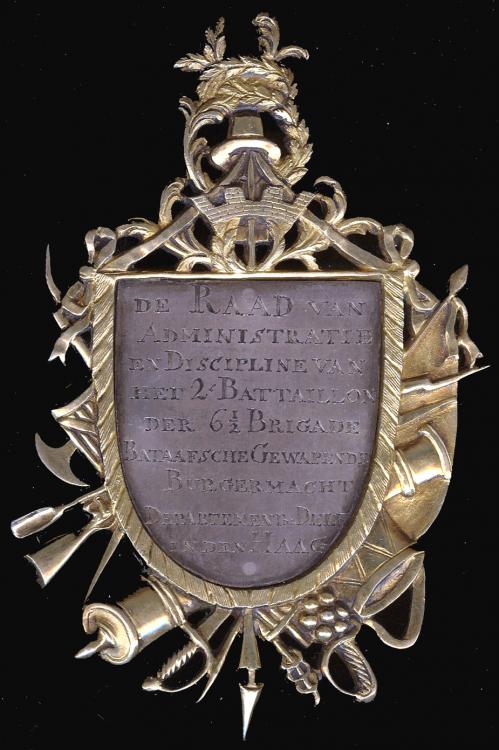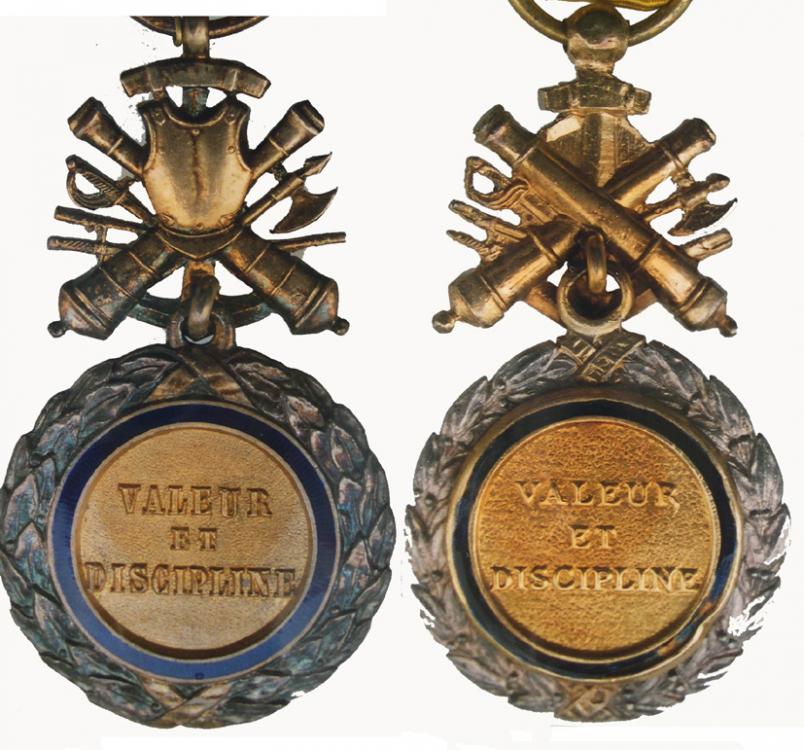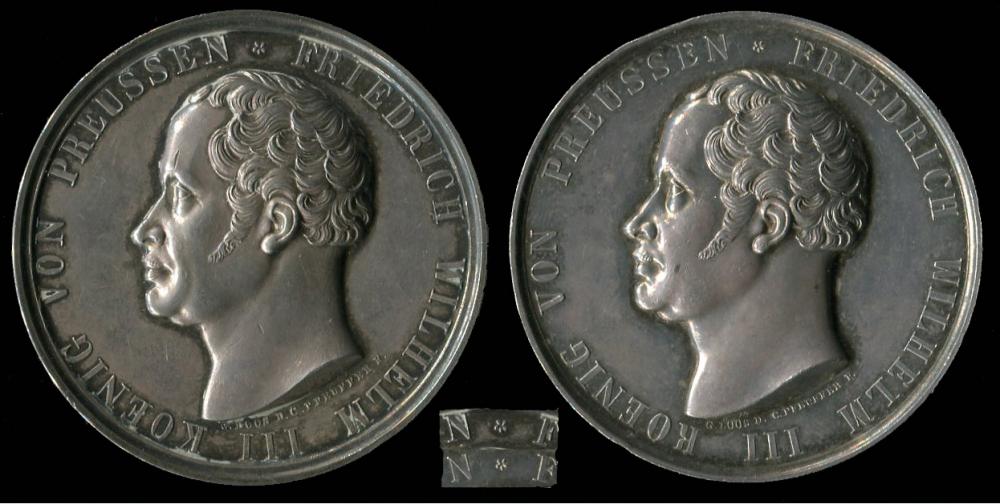-
Posts
782 -
Joined
-
Last visited
-
Days Won
2
Content Type
Profiles
Forums
Blogs
Gallery
Events
Store
Everything posted by Veteran
-
This is a VERY strange medal indeed ! I have collected French lifesaving material for over half a century and I cannot recall EVER having seen an UN-NAMED life saving medal such as this one. I am sure the reference you mention is correct. A first class silver lifesaving medal of this type was only awarded to a person who previously had received a second class silver medal or would have given absolytely outstanding services at his/her utmost risks. Congratulations ! Veteran
-

The Value of a Collection
Veteran commented on Brian Wolfe's blog entry in News From the Home Office.
Hello Brian, Your collection is part of your estate. The question is therefore : how do you handle your belongings ? The value of your collection is simple : it's worth what it can be sold for. How can you tell ? Offer it for sale, to a dealer, at auction, on eBay, whatever. But you don't want to sell it away. How could you tell what you can get for it ? You can have it valued by a competent auctionneer and pay him (her) a fee for the effort. You don't want to get into that sort of expense ? Have a complete inventory of your collection and keep posted on the prices you see offered in the trade, obtained in successful auctions (including cost to the buyer), or such places as eBay. Add up the prices you found. AND TAKE 50%. You might make more, but you will not make much less. I personnally would be happy to hear of an other approach. Veteran -
Hello turtle, This group is typical of post WW1 period. The only way to get this man's records is to find the "departement" (i.e. county) where he was born and probably draughted. The local archives would then be the place to research. A difficult task genealogists overcome when they are lucky. Sorry I cannot be more constructive. Veteran
-
It is a nice period piece, locally made by a Tunisian silversmith (hallmark for silver in the back); the center pieces were sometimes clumsily inserted. Or it might have been removed and replaced. Anybodie's gess, I would say. This order was widely awarded both to Tunisian nationals and to French administrators and military personnel even at rank level. The numbers of Beys (local rulers under French protectorate) and variety of manufacturers (both Tunisian and French). I have a feeling the series is gainiing interest with a larger number of collectors. It is well worth their attention, the various types still being very affordable.
-
Hello all A long time has elapsed since this post was initiated. I recently found a book which relates the awarding of the Lloyd's Medal to Dr. Kovache. Here it is should anyone be interested : Jim GAWLER. "LLOYD's MEDALS 1836-1989. Awards for courage and exceptionnal services". Hart Publishing Toronto 1989. It seems that this Silver Medal for Saving Life at Sea was presented in 1974 at Lloyd's. It was the last to bear this title, further awards being Lloyd's Medals for saving life. A total of 275 silver Life saving medals were issued between 1836 and 1989 over a period of 153 years, making it a truly scarce award. The reason why a British award should have been made to a Frenchman serving on a French ship for saving the lives of Greek sailors remains a mystery. Could it be because the tanker and its cargo could be saved ? Or was it because the action was in South African waters ? Suggestions would be most welcome. Veteran
-

NETHERLANDS; Late 18th Century badge.
Veteran replied to Veteran's topic in Northern European & Baltic States
Dear Guy Thank you for your prompt reply and translation of the inscription on the badge. This brings up a few questions : 1. Is this a badge of office or rank ? 2. Does it belong to one of the regular battalions of the Batavian Army or to a town-guard ? 3. Where could I possibly find further information about this specific badge and/or documentation on the specific unit it belonged to ? I believe it was meant to be worn on some kind of leather strap. Thank you again for your kind help. Veteran -
Hello everyone, This large badge, possibly silver and gilt silver, is a mystery to me. I rather suspect it has Something to do with a local militia town guard. Thank you for your help.
-
Hello Igor This is a very nice medaille militaire. To make it short, when the Medaille militaire was established by Napoleon III, the ribbon was suspended to an imperial eagle. After the fall of Napoleon III, the eagle was replaced a trophy of arms still which was sculptured on both sides and sodered to the medal itself. This proved to break easily and the trophy was attached to the medal by ring. The first of these loose trophies were sculptured on both sides, either with the two canons apparent or with the back part of a cuirasse covering them. Later, the run of the mill Medaille militaire were made with plain reverses Nevertheless some of the best manufacturers continued to offer medals of the obverse/reverse sculptured type and gold "bombé" centers. Those were the so called Medailles des généraux. I don't know if they are still available. Hope this clarifies the matter. Veteran
-
Hello Adrian, There is, unfortunately, no official list of awards to foreigners (non-French nationals). The style of the breast star indicates that the award was an early one (1964-1980). Your best bet would be to write to the French Military attache in Lisbon. He might have the necessary archives available. The alternative would be to write to the French Foreign Office who certainly have the archives, but no obligation to answer.... I sincerely hope this information will help you. It would be nice of you to report here the result of your possible inquieries. Veteran
-
Hi fellows, This "Major' has indeed seen foreign service (known as OPEX for OPerations EXterieures in French military jargon) !. It should possibly be mentionned that the rank of "Major" was relatively recently introduced to be given to very senior Non Commissionned Officers for whom it is the highest available. The true aristocracy in the Legion. The men in the back of the picture are Foreign Legion vétérans. They wear the traditionnal blue blazer, with white shirt, grey slacks green tie and green beret. Full size awards are always worn, never the reduced size.. All the best Veteran
-
Hello Igor, Your silver croix de guerre is a very nice one. The small "hole" on the obverse of the short section between the upper arm of the cross and the ball for the ring is the "boar-head" French hallmark for silver. You realise that it is not any special class or level of the croix de guerre, just a private refinement. Such crosses were available from a number of private firms who offered for sale badges not only in the normal bronze material, but also (at a higher cost) in silver or silver gilt. Not a special award of any kind. On the other hand, the palm in silver was meant to replace five bronze palms. I am not sure it was perfectly official, but it certainly was understood as such. French Air Force pilots would receive a large number of mentions in dispatches ("citation") each one with a new device on the ribbon of the pilot's cross. The use of silver palms for five bronze palms provided better looking décorations. A very nice cross which looks the period, very similar to this other one shown at the top of this message. Silver palms exist here too... and I cannot tell wether they are meant to replace five bronze palms each or if they are an "improved" appearance for bronze palms. It could have belonged to one of the "fly-boys" who would not generally have been challenged for such an initiative. Congratulations for this fine croix de guerre. They are quite scarce. Regards Veteran
-
Hi Chris is right. The Foreign Legion never used skulls, it just is not their tradition. I don'r know what is this lapel badge for sure. But I could venture a theory; The colours are those of the Medaille militaire which is the highest reward for bravery in the field for NCOs & other ranks. It also is the long and distinguished services award for the same personnel. The same duallity exists with the Legion of honor for officers. After WW1, a number of French officers who had received the order for gallantry felt they wanted to have something to tell this ; la "Société des membres de la Legion d'honneur decores au peril de leur vie" was established for this. Their lappel badge was a Legion of honor star enameled white with in the center a skull instead of the profile of the French Republic. That badge makes me think that NCOs who received their Medaille militaire for bravery might have wanted to do the same. I cannot prove this. All the best Veteran
-
Yes it is. The eagle head hallmark is used in France for 18 carat gold since 1847.
-
Thanks Paul, it's an interesting piece of news. Will look out for more if any exist, Best regards Veterans
-
Such orders and medals were made to serve as replacements for lost badges or to be arranged for wear on parade uniforms. I believe most of them were struck in solid silver with the appropriate french hallmark. None of the medals have swivelling ribbon bars. All the french made reproductions of British awards and medals that I have come across were for WW1. Whether replacement badges for WW2 were manufactured is open to debate.
-
Hi Andreas Thank you for your kind message. I must admit I gave up trying to get in, which was frustrating.y Life-saving awards have been one of my favorite series of medals : the type of simple courage often displayed to save others from Deadly dangers makes me wonder. I had no idea these life-saving medals were supposed to be returned at the death of recipient. Does that explain why German pieces are scarce ? I would love to join a group of collectors, if such a thing exists in Germany. French collectors debate a lot about them on Forum Insignes et Medailles. The group you show is very interesting. Do you know anything about the recipient. All the best Veteran
-
Hi Paul This information comes from the n°265 auction sale catalogue to be held in Osnabrück by the firm KUNKER next September 26. A large number of German States life-saving medals are on sale, and genereous information is given about Prussian awards pages 49-52. The catalogue can be seen on the 'net. These particular early large silver non wearable medals are described as having four successive strikings between 1833 and 1918; the small flower on the obverse had a five petaled flower on the first two (those discussed in my message) and two more bearing a seven petaled flower with various other différences. Thank you for your question. I hope further reactions will turn up. Veteran
-
Hello all, I would like to come back to the large 50mm diameter non wearable silver Prussian Life-saving medal mentioned earlier. To-day's Künker's 265 auction sale catalogue mentions a series of different types of the early issues. Apparently a first striking was made between 1833 and 1870 with a five-petaled flower on the obverse between the word PREUSSEN and the word FRIEDRIICH. About 1.500 such medals would have been awarded. A second type, which differs from the first by a smaller five-petaled flower at the same place was struck between 1871 and 1881 of which only 420 medals were issued, making this type much scarcer. According to these informations, I would like to submit the obverse pictures of two such medals : The picture on the left would be the "large" flower with the engraver's signature extending beyond the King's bust (it is the top flower as enlarged). Would then the picture on the right be the "lesser" flower with a shorter signature of the engraver ? The lower one on the enlarged picture.. Comments will be gratefully received. Regards Veteran
-
In the event, it appears his claim for a SWB was rejected, since he wasn't serving in a British or Empire unit. One member suggested that he write to the Legion's HQ in Marseille. Do any of our anciens have an opinion of his chances of success (assuming that Genn was born over 120 years ago)? Hello Michael To answer your question, there is probably no way to get any information from the Foreign Legion. The rule is : information about legionnaires are private. This is based on the rule that previous life of legionnaires are their own business. Their time with the Legion is a part of their lives they are free to communicate but no one is supposed to do so without their avail. The Foreign Legion Headquaters are in Aubagne, close to Marseilles but a different city. Sorry I cannot be more encourageing. But since you asked ... Hopefully some other ex-legionnaire may be more optimistic. Veteran
-
Hello all, The Prussian non wearable life-saving medal (Fred. Will. III) "FÜR RETUNG AUS GEFAHR" is mentionned by Nimmergut in two types : with KÖNIG and with KONIG in the legends. The same seems to have occured with the later waeareable types. Nimmergut gives quite different valuations according to the type. Is the reason for this known ? Incidentally, does an group of collectors of German life-saving medals exist.? Thank you for your attention and kind answers. They will be gratefully received. Veteran
-

Unknown non portable medaille - Arthus Bertrand BRONZE
Veteran replied to Uffz. Rohleder's topic in France
This type of medals was currently given between the 1880s and 1960s. I personnaly hav'nt come across this very one. Firefighters have traditionnally been volunteers in most of french provinces. They have often belonged to local firefighting societies which federated at regional level to share experiences and sometimes act as parteners to local officials. This could well be the case of the "Union des corps de sapeurs pompiers du Nord de la France". Such a medal could either be a token of recognition for services as a member of the Union or gjven to persons outside of the Union as a keepsake. It probably is not a medal for life-saving. Best regards Veteran -
Chris Thank you for the information. A few comments : The American NCO who received the Legion of honor clearly risked his life and a number of French airmen (one woman I believe) owed their lives to his brave action. The award of the Legion of honor to an NCO is a VERY unusual procedure, probably due to the fact that this galant airman was not a French Citizen. He certainly deserved the highest award available and I am glad the French Government did the right thing . The other four American airmen received the gold level National Defense Medal which is the equivalent of a Croix de guerre or a Croix de la Valeur militaire for gallantry in peacetime. I would be interested to know if these five men received recognition from the Italian Government and/or from the US Aiforce. They certainly are a credit to their Country. Regards Veteran





